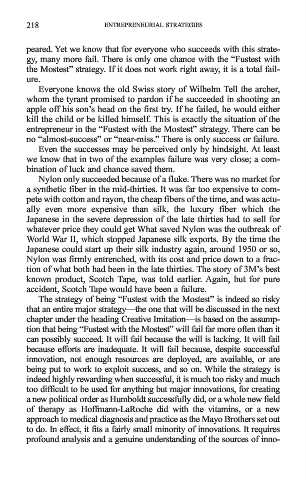Page 225 - ENTREPRENEURSHIP Innovation and entrepreneurship
P. 225
53231_Innovation and Entrepreneurship.qxd 11/8/2002 10:50 AM Page 218
218 ENTREPRENEURIAL STRATEGIES
peared. Yet we know that for everyone who succeeds with this strate-
gy, many more fail. There is only one chance with the “Fustest with
the Mostest” strategy. If it does not work right away, it is a total fail-
ure.
Everyone knows the old Swiss story of Wilhelm Tell the archer,
whom the tyrant promised to pardon if he succeeded in shooting an
apple off his son’s head on the first try. If he failed, he would either
kill the child or be killed himself. This is exactly the situation of the
entrepreneur in the “Fustest with the Mostest” strategy. There can be
no “almost-success” or “near-miss.” There is only success or failure.
Even the successes may be perceived only by hindsight. At least
we know that in two of the examples failure was very close; a com-
bination of luck and chance saved them.
Nylon only succeeded because of a fluke. There was no market for
a synthetic fiber in the mid-thirties. It was far too expensive to com-
pete with cotton and rayon, the cheap fibers of the time, and was actu-
ally even more expensive than silk, the luxury fiber which the
Japanese in the severe depression of the late thirties had to sell for
whatever price they could get What saved Nylon was the outbreak of
World War II, which stopped Japanese silk exports. By the time the
Japanese could start up their silk industry again, around 1950 or so,
Nylon was firmly entrenched, with its cost and price down to a frac-
tion of what both had been in the late thirties. The story of 3M’s best
known product, Scotch Tape, was told earlier. Again, but for pure
accident, Scotch Tape would have been a failure.
The strategy of being “Fustest with the Mostest” is indeed so risky
that an entire major strategy—the one that will be discussed in the next
chapter under the heading Creative Imitation—is based on the assump-
tion that being “Fustest with the Mostest” will fail far more often than it
can possibly succeed. It will fail because the will is lacking. It will fail
because efforts are inadequate. It will fail because, despite successful
innovation, not enough resources are deployed, are available, or are
being put to work to exploit success, and so on. While the strategy is
indeed highly rewarding when successful, it is much too risky and much
too difficult to be used for anything but major innovations, for creating
a new political order as Humboldt successfully did, or a whole new field
of therapy as Hoffmann-LaRoche did with the vitamins, or a new
approach to medical diagnosis and practice as the Mayo Brothers set out
to do. In effect, it fits a fairly small minority of innovations. It requires
profound analysis and a genuine understanding of the sources of inno-

